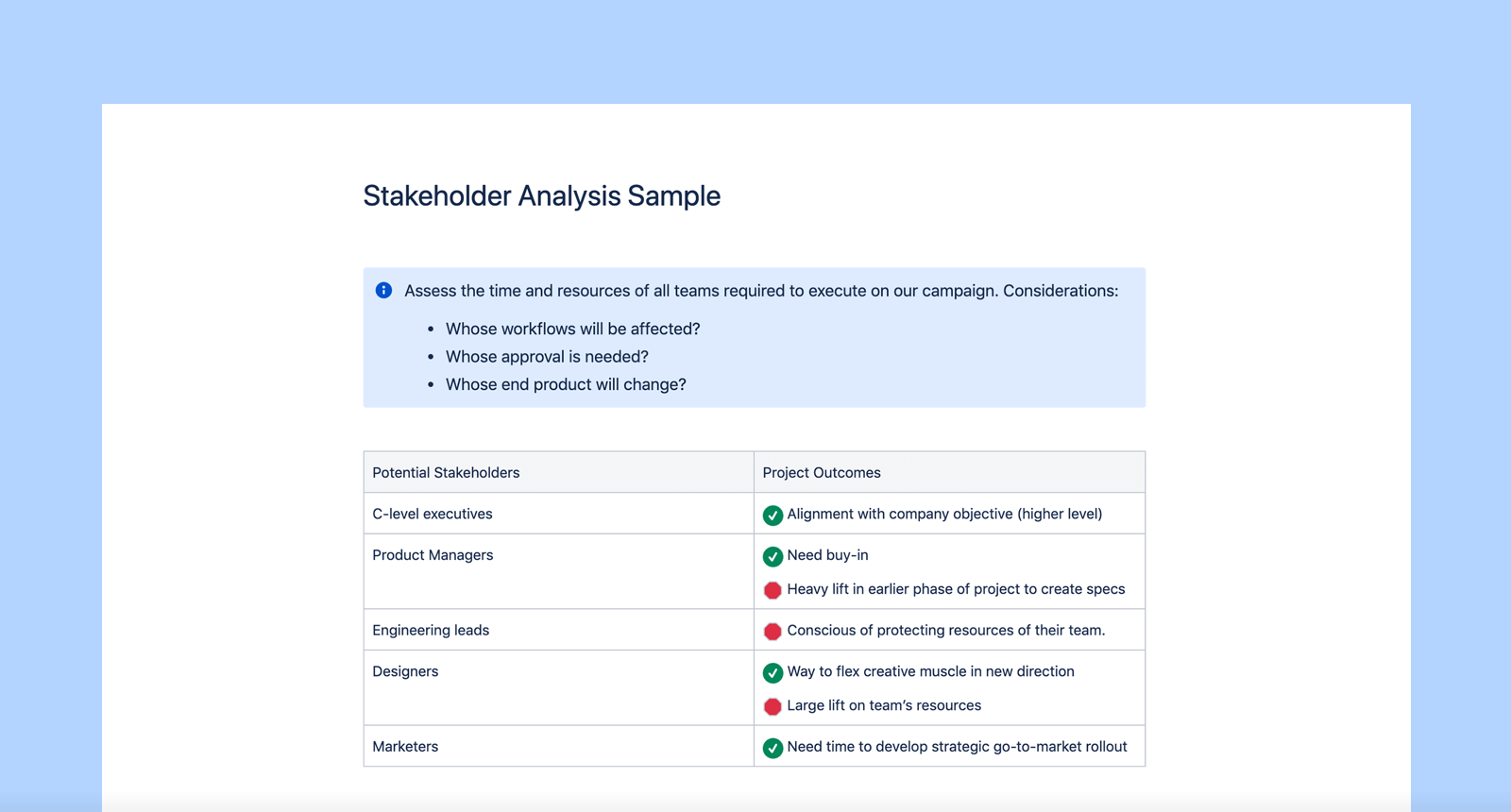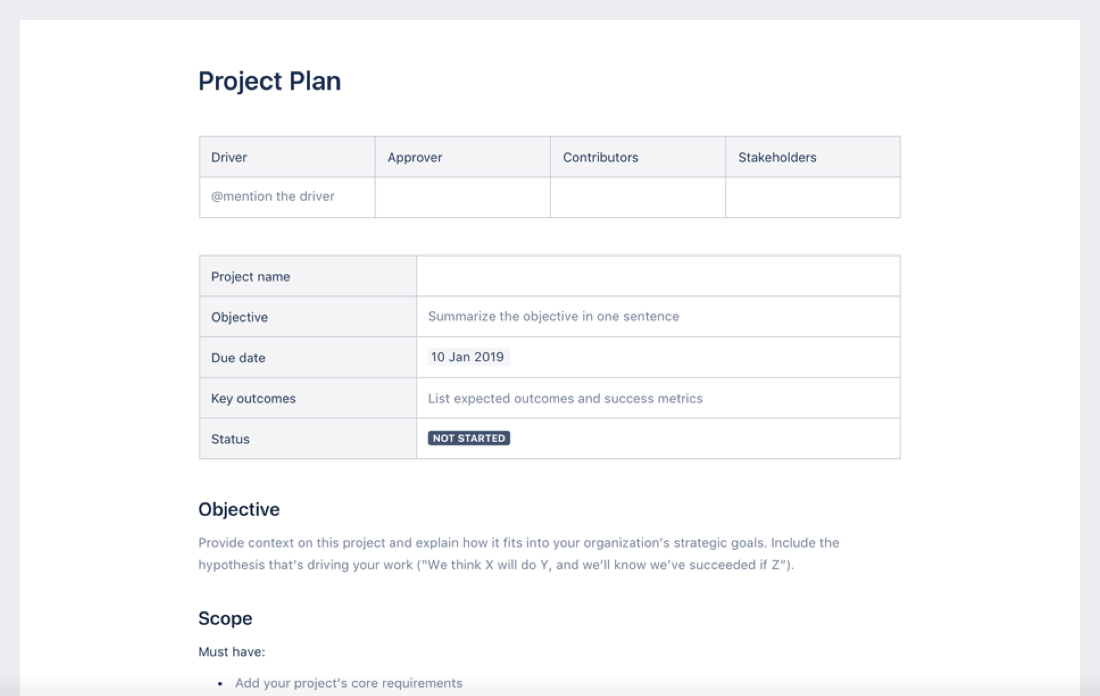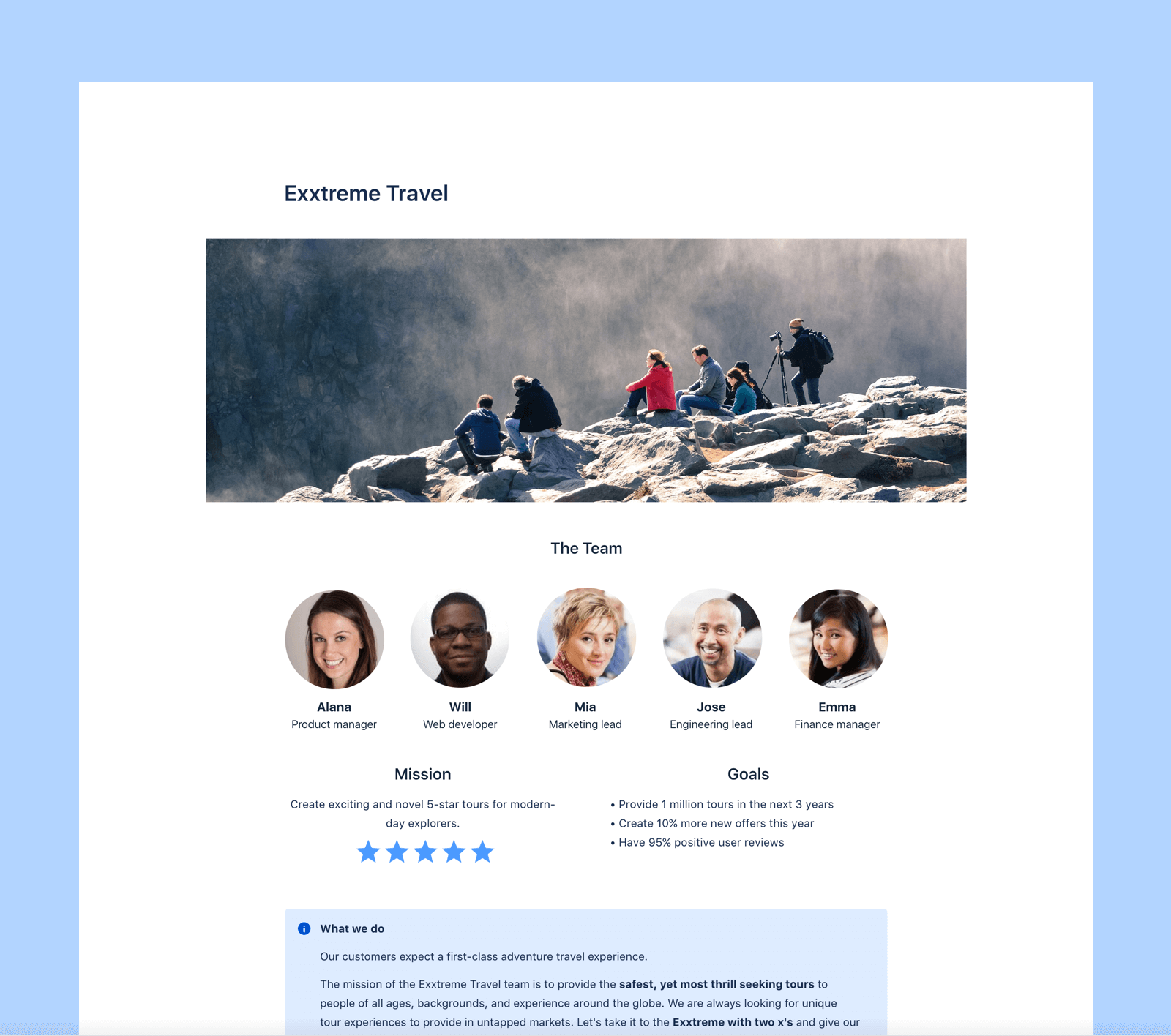The ultimate guide to stakeholder management
By Aumarie Benipayo
Whether launching a new product, implementing change, or driving a strategic initiative, engaging stakeholders correctly can make or break your efforts. Mastering stakeholder management equips you to navigate complex stakeholder landscapes, align interests, and drive projects forward with buy-in and support from all involved parties.
By understanding stakeholder needs, interests, and expectations, you can build strong relationships, foster collaboration, and mitigate risks. Effectively managing stakeholders ensures that your projects meet their objectives and resonate with those interested in their success.
This comprehensive guide defines stakeholder management, touches on its critical components, reviews best practices, and explores different techniques for effectively managing stakeholders.

What are stakeholders?
Stakeholders in business are individuals, groups, or companies interested in a project or decision because its outcome affects them. They can be internal or external.
Internal stakeholders are individuals or groups, including employees, managers, and executives, directly interested in the company’s operations, decisions, and performance.
External stakeholders are individuals or groups outside the company, such as customers, suppliers, investors, government agencies, and local communities. The company’s activities may affect them, or they may be interested in its success.
Whose workflows will be affected
Whose approval you’ll need to complete the project
Whose end product will change
What is stakeholder management?
Stakeholder management involves identifying, analyzing, engaging, and managing the needs and expectations of individuals or groups interested in or affected by a project. It requires anticipating who needs to know about and participate in different components at various project stages.
A project stakeholder management plan facilitates effective communication, addresses concerns, ensures stakeholder alignment with project goals, and ultimately contributes to project management and business success.

Key benefits of stakeholder management
Stakeholder management affects the success of a project or company. Here are several reasons why stakeholder management matters:
Struggling with managed dependencies or role confusion? Use the roles and responsibilities play to clarify who is doing what.
1. Enhanced project success
Successful stakeholder management aligns project goals with stakeholder expectations. Early and regular stakeholder engagement ensures their needs are understood and incorporated into project planning and execution. Alignment leads to better project outcomes, as stakeholders are more likely to support a project that addresses their concerns and delivers value.

Create a DACI right from the start for every project or campaign. That’s not to say you need to be rigid. Just set expectations up front for who needs to be consulted for a sign off and who has ultimate responsibility for getting it all done.
2. Better risk management
Stakeholder management helps identify potential risks and issues early in the project life cycle. Engaging with stakeholders allows project managers to anticipate and reduce risks before they escalate into major problems. Stakeholders can also provide insights into potential challenges.
3. Improved communication
Stakeholder management facilitates open and transparent communication between the project team and stakeholders. Regular communication keeps stakeholders informed about project progress, changes, and decisions. This transparency builds trust, fosters project collaboration, and ensures everyone remains on the same page. Effective communication also allows stakeholders to provide feedback and input.
4. Efficient conflict resolution
Stakeholder management helps identify and resolve conflicts between stakeholders with competing interests or priorities. Engaging stakeholders in open dialogue and negotiation can lead to mutually beneficial solutions. Project managers can use stakeholder analysis to understand power dynamics and the influence of different stakeholders.
5. Sustainable long-term relationships
Effective stakeholder management builds solid and long-lasting relationships between the company and its stakeholders. Regularly engaging with stakeholders, addressing their concerns, and delivering value fosters trust and loyalty. These positive relationships can lead to future opportunities, partnerships, and support for the company’s initiatives.
How to manage stakeholders effectively
Stakeholder management involves pinpointing, assessing, and engaging individuals or groups interested in or affected by a project.

Identifying stakeholders
Conduct a stakeholder analysis and determine roles and responsibilities early when preparing to launch a project involving other people. This process involves brainstorming sessions and assessing who the project’s outcomes will directly affect. Ask the following questions:
- Whose workflows will the project alter?
- Whose approval is necessary to complete the project?
- Whose end product will change?
You can use these techniques to identify the correct stakeholders for your project:
- Brainstorming sessions: Gather your project team and experts to brainstorm potential stakeholders.
- RACI matrix: A RACI chart clarifies roles and responsibilities by identifying who is responsible, accountable, consultable, and informed of each task or decision in the project.
- Power-interest grid: Assess and prioritize stakeholders based on their level of power and interest in the project. This can help determine engagement strategies.
- Stakeholder analysis matrix: Categorize stakeholders by their influence and interest using a matrix.
- Surveys and interviews: Gather detailed information about stakeholders’ needs, concerns, and expectations through surveys and interviews.
Analyzing stakeholders
Defining roles gives stakeholders clarity about the skills, insight, and time they need to contribute to a project. It also minimizes the perceived “empty space” in the project’s process. Use documentation to solidify those roles and keep them at the top of your mind throughout the project.
Atlassian places a 2x4 table at the top of every project-related document in Confluence so everyone knows where they stand. Atlassian uses the DACI framework to assign the following roles:
- A driver manages stakeholders and ensures timely decision-making.
- An approver has the final say in decision-making.
- Contributors offer expert opinions or direct involvement in the project.
- Informed stakeholders receive notifications of decisions.
Methods for stakeholder analysis include the following:
- Influence/impact grids: Plot stakeholders on a grid based on their level of influence and the project’s effect on them, which helps prioritize stakeholders and determine engagement strategies.
- Salience model: Assess stakeholders based on their power, legitimacy, and urgency. This helps identify key stakeholders who require the most attention and engagement.
- Stakeholder mapping: Develop a visual representation of stakeholders, their relationships, and their influence on the project. Stakeholder mapping helps identify key players, potential allies, and potential roadblocks. A flowchart is great for this task, try the free Stakeholder mapping template in Confluence to get started quickly.
- SWOT analysis for stakeholders: Conduct a SWOT (strengths, weaknesses, opportunities, threats) analysis for each stakeholder or stakeholder group to provide insights into how to best engage with stakeholders and address their concerns.
Engaging stakeholders
To properly engage stakeholders, you need to develop a plan for communication:
1. Get the kick-off right
Set communication expectations during the project kick-off meeting to ensure buy-in, determine a check-in cadence, and outline the decision-making process. Build this meeting around feedback while minimizing presentation time. Use a project roadmap to outline and review your project.
2. Centralize information sharing
Laying out all the relevant information for stakeholders communicates trust and eliminates unnecessary questions and meetings. It also empowers them to make decisions quickly and offer faster problem-solving.
Confluence offers easy access to information in a centralized documentation hub. These spaces showcase the project overview, goals, project scope, milestones, team member roles and responsibilities, recently updated pages, and relevant links.
3. Establish a communication strategy
Set a plan for communicating with stakeholders, or you’ll find yourself checking in “as you think of it,” which is exactly what you want to avoid. Setting dates, determining methods, and documenting check-ins are necessary for effective stakeholder management.
Handling stakeholder expectations
To manage stakeholders effectively, set realistic expectations from the outset. Communicate the project’s scope, objectives, deliverables, limitations, constraints, and potential risks.
When handling resistance to change, first identify concerned stakeholders. Proactively address their issues by communicating the benefits and necessity of the change. Focus on how it aligns with their interests. Involve resistant stakeholders in decision-making. This fosters a sense of ownership and buy-in. Provide training, support, and resources to help them adapt to the change.
Throughout the project, monitor and update expectations accordingly. Regularly communicate progress, milestones, and any deviations from the original plan. Actively listen to stakeholder feedback and promptly address their concerns. Adjust expectations as needed as the project evolves or circumstances change.
When making significant changes to the scope or deliverables, seek stakeholder input and approval. Consistent engagement maintains alignment and reduces misunderstandings.
Stakeholder management best practices
Stakeholder management best practices include identifying stakeholders early, involving them in decisions, tracking interactions, and resolving conflicts promptly.

Identify stakeholders early
Identify stakeholders from the outset to consider their needs during the planning phase. Use stakeholder analysis, mapping, and RACI matrices to understand their interests, concerns, and potential impact.
Involve stakeholders in decision-making
Involving stakeholders fosters a sense of ownership, increasing the likelihood of success. Communicate regularly with them, seek their feedback, and incorporate diverse perspectives into decisions.
This collaborative approach aligns expectations with goals and addresses concerns. Kanban boards and Gantt charts help visualize tasks and the project timeline, making it easier for stakeholders to understand the project flow and contribute effectively. These tools can improve productivity by providing clear visibility into project progress and bottlenecks.
Track stakeholder interactions
Maintain detailed records of all stakeholder interactions, including meetings, emails, and calls, ensuring you address all concerns and commitments. Use stakeholder registers, communication logs, or project management tools. Regularly review and update stakeholder information to reflect any changes.
Resolve conflicts as soon as possible
Conflicts among stakeholders with competing interests are common. Address them promptly before escalation impacts progress.
Addressing conflicts maintains positive relationships. Encourage open communication to understand root causes. Seek mutually beneficial solutions through negotiation and compromise. If needed, neutral third parties should be involved in mediating.
Level up your stakeholder communication with Confluence
It can prove challenging to inform and align stakeholders, especially when working across teams or locations. Stakeholder management empowers people and teams to function at their best while minimizing hang-ups.
Doing the hard work up front to give stakeholders clarity will start you off with a strong foundation as a project manager. But without a centralized communication platform, you may face issues, such as missed updates, lack of transparency, miscommunication, difficulty tracking feedback or decisions, and inefficient communication channels.
Use Confluence to level up stakeholder communication. It has several key features and benefits:
- Centralized hub: Create dedicated spaces/pages for each project to share updates, documents, and discussions with all stakeholders.
- Real-time collaboration: Let stakeholders comment, provide feedback, and collaborate on documents, which fosters transparency and alignment among teams.
- Communication plan template: Employ the free Confluence communication plan template to define your strategy, including stakeholders, methods, frequency, and content.
- Notifications and @mentions: Keep stakeholders informed by @mentioning them in relevant pages/comments and enabling notifications.
- Integrations: Seamlessly integrate with tools such as Jira and Trello for centralized access to project information.
With the free stakeholder communication plan template from Confluence, you can streamline stakeholder communication, improve transparency, and ensure alignment throughout the project life cycle.
End the endless update meetings. Set up your project in Atlas to make updates as easy as a Tweet. Every Friday, you’ll get a reminder to post an update, and every Monday your stakeholders will get the update. No meetings required.